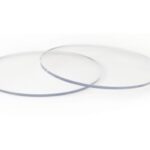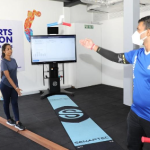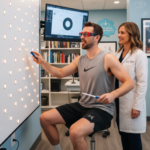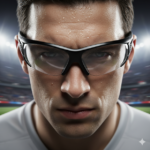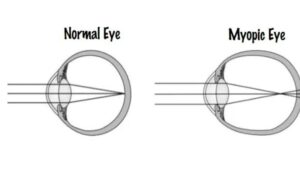Sports is not only about strength, skills, and endurance, but also about vision. Clear and stable eyesight is essential for athletes to perform at their best. From catching a fast cricket ball to shooting a basketball with precision, visual clarity and comfort can make the difference between winning and losing. Traditionally, athletes have relied on spectacles for vision correction. However, in recent decades, contact lenses have emerged as a safer, more practical, and performance-enhancing option. This blog explores the vital role of contact lenses in sports eye safety, their advantages, and why they are now considered an essential part of sports vision care.
Why Eye Safety Matters in Sports?
Sports-related eye injuries are common and can be serious. According to studies, thousands of athletes worldwide suffer from eye injuries each year, many of which could have been prevented with proper vision correction and protective measures.
– Contact sports like football, hockey, or basketball involve frequent collisions, making spectacles risky because lenses or frames can break and injure the eye.
– Fast-paced sports such as tennis, badminton, or cricket demand quick reaction times, where even minor visual distortion can reduce performance.
– Outdoor activities like cycling or running expose athletes to dust, wind, and UV radiation, which can harm unprotected eyes.
In this context, contact lenses not only improve vision but also minimize injury risks compared to spectacles.
Advantages of Contact Lenses in Sports
1. Wider Field of Vision
Spectacle frames often block peripheral vision. Athletes need a complete field of view to track opponents, teammates, or fast-moving objects. Contact lenses move with the eye and provide natural, unobstructed peripheral vision.
2. Reduced Risk of Injury
Glasses can slip, fog up, or even break on impact, causing injury. Contact lenses eliminate this danger, making them a safer option.
3. Stability During Movement
During intense activity, glasses can shift or fall. Contact lenses stay securely on the eye surface, providing stable and consistent vision correction.
4. Better Compatibility with Protective Gear
Helmets, masks, or goggles often conflict with spectacles. Contact lenses fit seamlessly.
5. Enhanced Visual Quality
Modern contact lenses reduce glare, reflections, and sometimes filter harmful UV rays.
Contact Lenses vs. Spectacles in Sports Safety
Feature | Spectacles | Contact Lenses
—————-|——————-|—————-
Field of Vision | Limited | Full
Risk of Injury | Breakage risk | Minimal
Stability | Can slip/fog | Stable
Compatibility | Uncomfortable | Fits easily
Visual Quality | Glare/reflections | Clearer vision
Special Considerations for Athletes Using Contact Lenses
1. Daily disposable lenses reduce infection risk.
2. Silicone hydrogel lenses provide higher oxygen permeability.
3. UV protective lenses help outdoor players.
4. Rewetting drops prevent dryness.
5. Professional fitting is essential.
Limitations and Precautions
– Contact lenses require proper hygiene.
– Not ideal for swimming unless combined with goggles.
– Some athletes still prefer prescription sports goggles.
The Role of Optometrists in Sports Eye Care
Optometrists help athletes by:
– Assessing visual demands of the sport.
– Recommending suitable lenses.
– Educating on hygiene.
– Providing follow-ups.
Conclusion
Sports demand sharp, stable, and safe vision. Contact lenses provide wider vision, reduce injury risks, and enhance performance. They are an important part of sports eye safety. With professional guidance, they can be a game-changer in sports vision care.
Future Trends in Sports Contact Lenses
The future of sports vision is exciting, with new technologies being developed to improve both performance and safety. Smart contact lenses are currently being researched, which may one day provide athletes with real-time data such as heart rate, hydration levels, or even performance analytics directly through the eye. Other innovations include lenses designed with enhanced UV filters, blue-light protection, and specialized tints to improve contrast sensitivity for outdoor sports. For instance, amber-tinted lenses may help tennis players track the ball more effectively against a bright background, while gray-tinted lenses can reduce glare for cyclists and runners.
Psychological Benefits of Contact Lenses in Sports
Beyond physical safety and visual clarity, contact lenses can also have psychological benefits for athletes. Wearing glasses can sometimes make athletes feel self-conscious or distracted, especially during competitions. Contact lenses, being nearly invisible, allow athletes to focus fully on their game without worrying about appearance or discomfort. This can improve confidence levels and reduce performance anxiety. Many athletes report feeling more natural with contact lenses, which helps them stay mentally sharp and engaged.
Case Examples
Professional athletes across different sports have embraced contact lenses as part of their performance toolkit. For example, baseball players often prefer contact lenses because they provide a clear view of the ball in flight without the risk of glasses fogging up. Similarly, footballers benefit from the stable vision that contact lenses offer, ensuring that quick head movements do not compromise clarity. These real-world examples highlight how contact lenses are not just for vision correction but also for competitive advantage.
Final Thoughts
In conclusion, the role of contact lenses in sports eye safety extends beyond traditional vision correction. They represent a fusion of safety, performance, and psychological confidence that athletes need to succeed. As technology continues to advance, the contribution of contact lenses in sports will only grow stronger, making them an indispensable element of modern athletic care.


